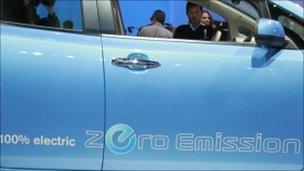Why Nissan thinks £24,000 new Leaf will rule road
- Published
The Leaf has a range of 100 miles
What do you think the future of motoring looks like? Nissan would argue it's a lot like their new car, the Leaf.
It is the first mass-produced electric car to be purpose built and go on sale in the UK.
Some other electric cars are based on existing internal combustion engine designs, and in case you're wondering the G-Wiz - which is seen all over London - is not a car, it's a quadricycle...
But will it be practical for ordinary drivers when they start taking delivery in March?
We were given exclusive access to the car to find out.
First of all, the numbers: it is going to cost £23,990 - and that is after taking into account a £5000 government subsidy.
So it's not cheap.
It will do 90mph and travel 100 miles on a full charge - as long as you don't use the air conditioning or heating.
Nissan say that you should be able to fully charge the battery from flat for £2.
Not for touring
A standard charge will take around eight hours, although it is possible to get the majority of the capacity in half an hour if there's a higher current charging point available.
That means it is not going to be practical as a car to tour the country in.
Filling up at motorway service stations is not currently an option although its manufacturer argues that's not a problem.
"The majority of customers will be people who are using it for commuting," says Richard Candler from Nissan UK.
"So the majority of drives and commuting drives are within a hundred miles. It's excellent as either a city car or an inter-urban commuting vehicle."
The Leaf will be imported for customers initially but from 2012 its batteries will be made at a factory in Sunderland.
And from 2013 the car will be produced there too.
Electric cars of course are very quiet.
That is an advantage as well as a disadvantage.
Nissan found for example that wind noise - because it wasn't drowned out by the engine - became more intrusive.
Bumper loudspeaker
So it designed the headlamp clusters to deflect air around the wing mirrors - where a lot of the wind noise comes from.
And to address concerns about pedestrians being unable to hear the car coming at low speeds, it has got a loudspeaker behind the bumper which plays a sound like a turbine as a warning.
Other hi-tech elements include a solar panel to help charge the 12v battery - so it doesn't take too much power from the main battery - and an option to link the car to smartphones - so you can tell it to warm up the interior in advance.

The Leaf on show at the LA Auto show this week is 100% electric and zero-emmission
Though if it is not plugged into a charging point, that is going to drain the battery and cut your range.
Manufacturers are competing to get electric cars to market - and they will all be playing the green card.
The Leaf will even give owners instructions on how to drive more economically - and if drivers want to, they can upload their own driving data to see how they compare with other drivers around the world in a global competition to see who can use the least electricity.
But the car is not a perfect solution.
Behaviour change
"We've always said that technology is part of the answer but to be truly green we've got to have renewable power to power our electric cars," says Tony Bosworth from Friends of the Earth.
"And we've always said that behaviour change is an important part of the solution. We've got to change how people travel if we want to tackle transport's contribution to climate change, and we've always said that the car industry can't just focus on electric cars."
At the moment the big problem - apart from the price - is the lack of infrastructure and charging points.
Honda has argued that long term the solution is electric cars powered by a hydrogen fuel cell.
It claims battery technology will simply never be able to satisfy all our motoring needs.
The disadvantage with hydrogen is that it has to be transported around the country to new filling stations, using fuel to do so, whereas electricity is already there and available.
The eventual solution may well be a combination of different technologies - with people choosing the one that suits their needs best.